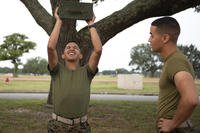Which is better, running on the ground or running on a treadmill? The answer depends on what you are training for and on local weather conditions (such as ice, heat, pollution). Most people either enjoy running inside on a treadmill or absolutely hate it and prefer to feel their feet on the ground.
Regardless of which camp you are in, running on either is better than not running at all if you have an upcoming fitness test. Here is an email question from a young man considering serving in the military:
Hey, Stew. I'm looking into starting a military career in the next year. I'm new to running as well. I was wondering if it is true that a 2% incline on a treadmill will simulate track running? And if I can complete a 12-minute, 1.5-mile run on a treadmill with incline, would that be the same as running on a track? Thanks! Bob
Good question, Bob. That depends on the treadmill. From my experience, the 1% to 2% incline on most treadmills is a perfect way "to get close" to real running, but the speeds may be calibrated differently depending on the machine's age and mode.
However, motorized treadmills always will do some of the work for you, because you do not have to pull your body forward as your foot hits the ground on each step. Treadmill running leaves the muscles required to pull and push you forward underdeveloped, even though you are developing your heart and lungs similarly to ground running.
Neglecting these muscles could lead to imbalances that cause injury when you run on the ground. You should mix it up with treadmill running, ground running and non-impact cardio machines. Sometimes, we need a break from the impact of running but still need to maintain our heart and lungs by doing some form of cardio.
Do not neglect the muscle groups left undeveloped by the treadmill. Get on a track, turf field or pavement, if only for part of your running, each week. If weather conditions are driving you indoors, try to find a place with an indoor track, basketball court or turf field to get in as much real running as you can.
Running a few sets of shuttle runs, intervals or beep tests can be a good way to get the needed running muscles developed enough to avoid the types of imbalances that running only on a treadmill may cause.
In the military, you will be tested on ground in the form of either a track or known running course. There will be very little running on a piece of cardio gym equipment, aside from rehabilitation with a physical therapist after injuries.
Your goal is to avoid injuries by building a sturdy running foundation, mixing in sprints, goal pace running, hills and fast and slow intervals. You need to use tracks, turf, pavement, trails and sand -- both with and without added weight (rucking).
If you maximize the diversity of your running impacts, you will become more durable and succeed, no matter what the military requests of you.
There are curved (non-motorized) treadmills that provide a better running simulation if you can find them in your local gym. These help me develop muscle memory for the pace that I want on timed runs. The motorized machines set the speed and pace for you, but they are not always perfectly calibrated.
If you want to truly test your goal pace for timed runs, go to a track or somewhere with a known running distance of a quarter-mile or 400 meters and set a timer for a comfortable pace that is maintainable for you at the distance of your timed run event in the military.
You may need weeks or months of workouts to meet the full distance at your goal pace. Once you know how that pace feels, you can apply that to treadmill running and do many of your workouts inside when the weather is not cooperating.
Eventually, you will want to do some track runs just to confirm your progress, especially if you know you are testing on a track. Don't just hope your training is working for you. You want to know it is working by testing both methods.
Stew Smith is a former Navy SEAL and fitness author certified as a Strength and Conditioning Specialist (CSCS) with the National Strength and Conditioning Association. Visit his Fitness eBook store if you're looking to start a workout program to create a healthy lifestyle. Send your fitness questions to stew@stewsmith.com.
Want to Learn More About Military Life?
Whether you're thinking of joining the military, looking for fitness and basic training tips, or keeping up with military life and benefits, Military.com has you covered. Subscribe to Military.com to have military news, updates and resources delivered directly to your inbox.



















